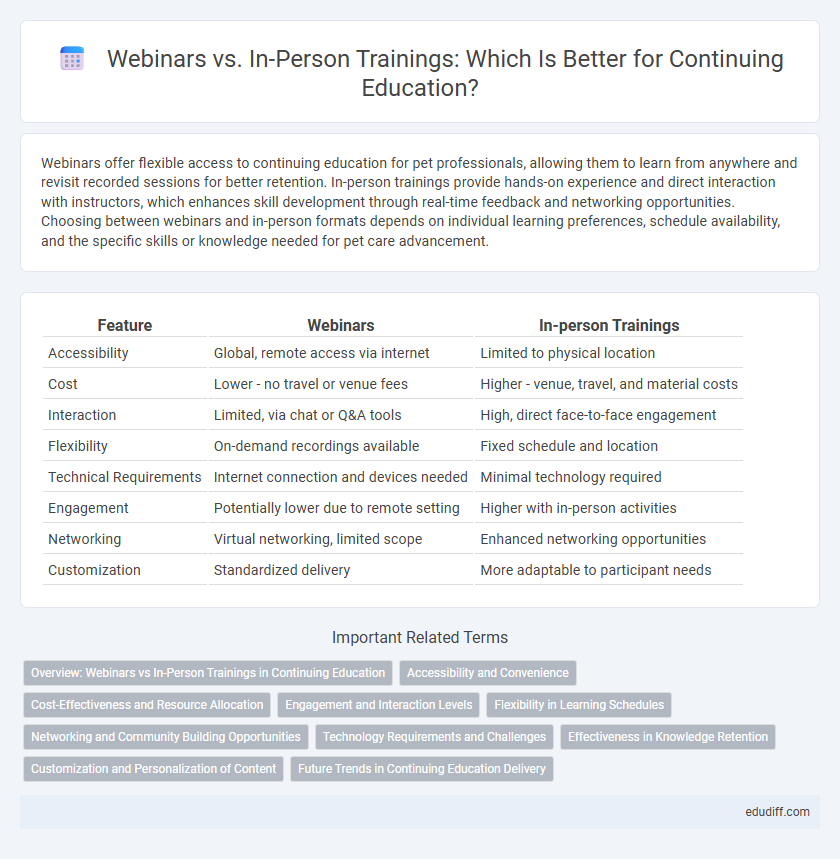Webinars offer flexible access to continuing education for pet professionals, allowing them to learn from anywhere and revisit recorded sessions for better retention. In-person trainings provide hands-on experience and direct interaction with instructors, which enhances skill development through real-time feedback and networking opportunities. Choosing between webinars and in-person formats depends on individual learning preferences, schedule availability, and the specific skills or knowledge needed for pet care advancement.
Table of Comparison
| Feature | Webinars | In-person Trainings |
|---|---|---|
| Accessibility | Global, remote access via internet | Limited to physical location |
| Cost | Lower - no travel or venue fees | Higher - venue, travel, and material costs |
| Interaction | Limited, via chat or Q&A tools | High, direct face-to-face engagement |
| Flexibility | On-demand recordings available | Fixed schedule and location |
| Technical Requirements | Internet connection and devices needed | Minimal technology required |
| Engagement | Potentially lower due to remote setting | Higher with in-person activities |
| Networking | Virtual networking, limited scope | Enhanced networking opportunities |
| Customization | Standardized delivery | More adaptable to participant needs |
Overview: Webinars vs In-Person Trainings in Continuing Education
Webinars in continuing education provide accessible, cost-effective learning opportunities that accommodate diverse schedules and geographic locations. In-person trainings offer hands-on experience and direct interaction, enhancing engagement and immediate feedback. Both formats support skill development, but selection depends on learning objectives and participant needs.
Accessibility and Convenience
Webinars offer unparalleled accessibility by allowing participants to join from any location with internet access, eliminating travel time and costs. In-person trainings provide hands-on experiences but often require significant logistical planning and physical presence, limiting convenience for some attendees. The flexibility of webinars supports diverse schedules and time zones, making them ideal for a global audience.
Cost-Effectiveness and Resource Allocation
Webinars offer significant cost-effectiveness by eliminating travel, venue, and printed materials expenses, allowing organizations to allocate resources more efficiently. In-person trainings often require substantial investment in logistics and time, which can strain budgets and reduce overall return on investment. By leveraging digital platforms for webinars, companies can maximize reach and minimize costs while optimizing resource distribution for training initiatives.
Engagement and Interaction Levels
Webinars offer convenient access and flexible participation but often face challenges in maintaining high engagement and interactive dynamics compared to in-person trainings. In-person sessions facilitate real-time feedback, spontaneous discussions, and more effective networking, driving deeper learner involvement. Interactive tools in webinars like polls and Q&A can partly bridge the gap but rarely match the immersive engagement of face-to-face environments.
Flexibility in Learning Schedules
Webinars offer unmatched flexibility in learning schedules, enabling participants to join sessions from any location without time constraints. In-person trainings require fixed schedules and physical presence, which can limit accessibility for those with busy or unpredictable calendars. This flexibility in webinars supports better work-life balance and accommodates diverse learning paces.
Networking and Community Building Opportunities
Webinars provide convenient access to expert knowledge but often lack the organic networking and relationship-building found in in-person trainings. Physical events facilitate spontaneous interactions, group activities, and deeper community connections essential for professional growth. Stronger networking opportunities at in-person trainings contribute to long-term collaboration and support within industry communities.
Technology Requirements and Challenges
Webinars require stable internet connections, compatible software platforms like Zoom or Microsoft Teams, and devices equipped with cameras and microphones to ensure seamless communication. In-person trainings demand physical venues with reliable audiovisual equipment, adequate seating arrangements, and real-time technical support to address any hardware or connectivity issues. Both formats face challenges such as managing participant engagement, troubleshooting technology disruptions, and ensuring accessibility across diverse user environments.
Effectiveness in Knowledge Retention
Webinars leverage multimedia tools and interactive features that enhance engagement, leading to improved knowledge retention compared to traditional lectures. In-person trainings provide face-to-face interaction and hands-on experiences, which can deepen understanding and memory retention for complex subjects. Studies indicate that combining both formats often yields the highest effectiveness in sustaining long-term knowledge retention.
Customization and Personalization of Content
Webinars enable dynamic customization through real-time polling, chat interactions, and adaptive content tailored to participants' responses, enhancing engagement and learning outcomes. In-person trainings allow for tactile customization, including hands-on activities and immediate instructor feedback, fostering a deeper personal connection and skill mastery. Both formats benefit from pre-assessment data to personalize content, but webinars leverage technology for scalable, instant adjustments across diverse audiences.
Future Trends in Continuing Education Delivery
Emerging technologies such as virtual reality and augmented reality are set to revolutionize continuing education by enhancing the immersive experience of webinars beyond traditional screens. Personalized AI-driven learning platforms will enable tailored content delivery, improving engagement and retention within both virtual and in-person training formats. Hybrid models combining synchronous webinars with localized in-person interactions are predicting increased flexibility, accessibility, and effectiveness in future skill development programs.
Webinars vs In-person Trainings Infographic

 edudiff.com
edudiff.com